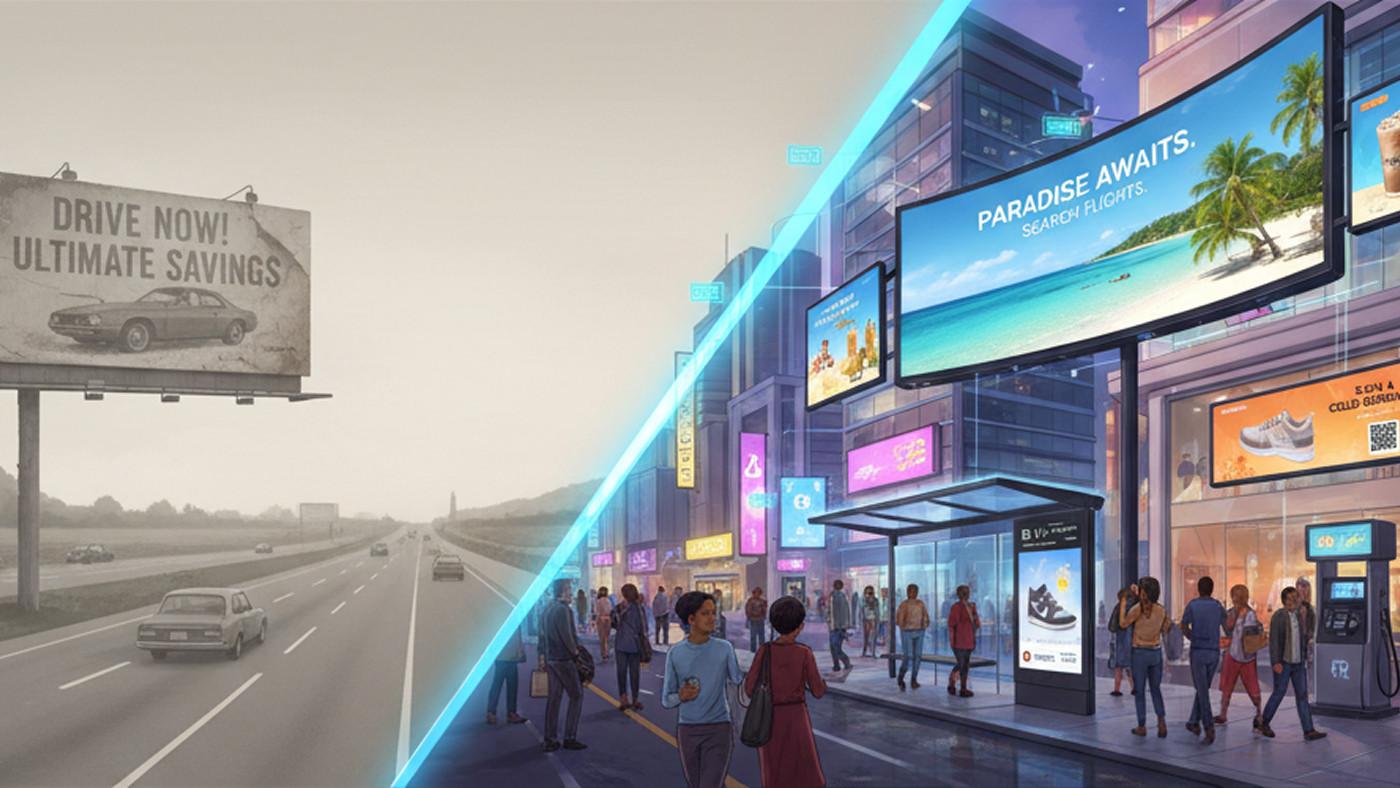
Picture a familiar scene from the recent past: a sprawling paper billboard on the side of a highway. Its message, printed weeks ago, is static, faded, and delivered indiscriminately to every driver who passes by. It’s a monologue, a fixed statement broadcast to the world. Now, contrast that with the vibrant, dynamic screens that increasingly define our public spaces today. Think of the full-motion video in a city square, the real-time transit updates at a bus stop, the interactive product displays in a shopping mall, or the short, engaging clips at the gas pump.
This dramatic transformation is the essence of Digital-Out-of-Home (DOOH) advertising. It represents more than a simple technological upgrade from print to pixel; it is a fundamental shift in how brands communicate with people in the physical world. DOOH turns public spaces into intelligent, responsive communication channels, bridging the gap between our online lives and our offline experiences.
This guide will provide a comprehensive exploration of the DOOH landscape. It will deliver a clear definition of what DOOH is, break down its powerful advantages over traditional methods, take a tour of its diverse formats, draw inspiration from world-class campaigns, and offer a glimpse into its data-driven future. The goal is to equip any business leader with a clear, actionable understanding of this essential modern advertising strategy.
1. Defining the Digital Shift: What Exactly is DOOH Advertising?
At its core, Digital-Out-of-Home (DOOH) advertising is the technologically enhanced evolution of traditional Out-of-Home (OOH) advertising. It utilizes digital screens—such as LED billboards, LCD displays, and interactive kiosks—to deliver dynamic, targeted, and measurable content in public spaces like airports, shopping malls, and transit stations. It is designed to capture the attention of consumers when they are "on the go" and away from their personal devices, making it a powerful tool for reaching people throughout their daily journeys.
The "OOH 2.0" Analogy
It is helpful to think of DOOH as "Outdoor Advertising 2.0." While traditional OOH—static billboards, printed posters, and vehicle wraps—has long been effective for building broad brand awareness, DOOH infuses this mass-reach medium with the intelligence, flexibility, and precision of digital marketing. It achieves this by leveraging modern advertising technology (AdTech), including geolocation, audience tracking, real-time data feeds, and advanced measurement analytics. This technology transforms a one-to-many broadcast medium into a far more relevant one-to-some, or even one-to-few, communication channel.
The most fundamental difference lies in the shift from static print to dynamic digital content. A traditional billboard displays a single, unchanging message for the duration of a campaign. A DOOH screen, however, can showcase a loop of advertisements, feature full-motion video, display live data feeds like weather forecasts or sports scores, integrate real-time social media streams, and even incorporate interactive elements. This dynamic nature makes the content inherently more engaging, attention-grabbing, and memorable.
This evolution from a static to a dynamic medium signifies a deeper operational change. The traditional OOH model is centered around media buying—contracting for a physical space for a fixed period, with logistics involving printing and manual installation. In contrast, the DOOH model is software-driven. Its logistics are digital and revolve around content management: uploading media files, scheduling playlists, and setting automated display triggers through a centralized software platform. This means that for a business to effectively leverage DOOH, it must develop a new competency in agile content management, moving beyond simple media placement. The success of the technology is therefore intrinsically linked to the power and usability of the software that controls it.
DOOH vs. Traditional OOH at a Glance
To fully appreciate the paradigm shift that DOOH represents, a direct comparison is essential. The following table breaks down the key differences between the two approaches, highlighting the strategic advantages that digital technology brings to out-of-home advertising.
| Feature | Traditional OOH (Out-of-Home) | Digital-Out-of-Home (DOOH) |
|---|---|---|
| Content | Static (Printed paper, vinyl) | Dynamic (Video, animations, live feeds, interactive content) |
| Flexibility | Fixed for the entire campaign duration | Real-time updates; content can be changed remotely in seconds |
| Targeting | Broad, based on physical location only | Precise & data-driven (time of day, weather, demographics, live events) |
| Interactivity | Passive, one-way communication | High potential (QR codes, touchscreens, social media integration, augmented reality) |
| Measurement | Estimates based on traffic counts and surveys | Data-driven metrics (impressions, dwell time, engagement, footfall analysis) |
| Lead Time & Cost | Long lead time (printing, installation); high upfront cost for long campaigns | Instantaneous deployment; flexible pricing (pay-per-play/impression), lower long-term operational costs |
| Environmental Impact | Physical waste from printed materials | Paperless and energy-efficient, supporting sustainability goals |
2. The Strategic Advantages: Why Your Business Needs to Pay Attention to DOOH
The transition to digital brings a host of strategic benefits that make DOOH an indispensable tool for modern marketers. These advantages move beyond aesthetics, offering tangible improvements in efficiency, relevance, and performance.
Unmatched Flexibility and Real-Time Control
Perhaps the most significant advantage of DOOH is its unparalleled flexibility. Unlike static media, where a message is locked in for weeks or months, DOOH content can be updated remotely and in real-time. This capability opens up a world of dynamic advertising strategies:
- Dayparting: This strategy involves tailoring content to specific times of the day. A classic example is a fast-casual restaurant displaying breakfast promotions in the morning, lunch specials around noon, and dinner advertisements in the evening—all on the same digital screen. This ensures the message is always relevant to the immediate needs of the audience.
- Weather-Triggered Ads: DOOH systems can be programmed to react to live weather data. A retail store could automatically display ads for umbrellas and raincoats the moment it starts to rain, or a beverage company could promote iced coffee as soon as the temperature rises above 25°C. This level of contextual relevance makes the advertisement feel less like an interruption and more like a timely suggestion.
Precision Targeting in the Physical World
DOOH brings the sophisticated targeting capabilities of online advertising to physical locations. Using aggregated and anonymized mobile location data, advertisers can gain insights into the movement patterns and demographic profiles of audiences in specific areas, all while respecting individual privacy. This enables highly strategic targeting:
- Geotargeting: Advertisers can select screens in specific geographic areas that over-index for their target audience.
- Point-of-Interest (POI) Targeting: A brand can strategically place ads on screens surrounding a key location. For instance, an energy drink company could run ads near sports stadiums on game day, or a luxury brand could target screens in and around a competitor’s flagship store. This allows for precise, competitive messaging at moments of high relevance.
Captivating Audiences and Boosting Engagement
The human brain is hardwired to notice light and motion. The dynamic nature of DOOH content—with its bright colors, video, and animation—is inherently more attention-grabbing and memorable than a static print advertisement.Beyond simply capturing attention, DOOH can also drive active engagement by serving as a bridge to a brand's digital channels. Interactive features like QR codes can direct users to a website for a special offer, live social media feeds can display user-generated content in real-time, and touchscreen displays can even offer gamified experiences. This transforms the advertising encounter from a passive viewing into an active participation.
This ability to react to the environment in real-time fundamentally changes the nature of advertising. A traditional ad is a monologue—a predetermined message broadcast into a space regardless of the conditions. A dynamic DOOH campaign, however, creates a dialogue with the environment itself. For example, Audi ran a campaign where roadside screens promoted different assistive technologies based on live traffic data; in heavy traffic, the ad highlighted the "Pre-Sense" feature. Similarly, the Aruba Tourism Authority ran ads in cold North American cities that displayed the real-time temperature difference between the viewer's location and the sunny beaches of Aruba. In these instances, the advertisement is no longer an interruption in the environment; it becomes a relevant piece of information about the environment. This profound shift from interruption to integration is what makes DOOH so powerful, making the message feel less like an ad and more like helpful, timely content.
Demonstrating Measurable ROI
For decades, measuring the true impact of OOH advertising has been a significant challenge, often relying on estimations based on traffic counts and surveys. DOOH changes this by introducing the data-driven accountability of digital marketing. Modern DOOH platforms can provide a wealth of concrete performance metrics, allowing businesses to track effectiveness and optimize campaigns for better results. Key metrics include:
- Impressions: The number of times an ad was likely seen by an individual.
- Dwell Time: The average amount of time people spent looking at the screen.
- Footfall Analysis: By partnering with data providers, it's possible to measure the "lift" in store visits from people who were exposed to a DOOH ad, directly linking campaign exposure to in-store traffic.
This ability to measure, analyze, and optimize provides the clear return on investment (ROI) that modern, data-focused businesses demand.
3. The DOOH Ecosystem: A Tour of Formats and Locations
Digital-Out-of-Home is not a monolithic channel. Instead, it is a diverse and expanding ecosystem of screen types and formats, each suited to different environments and marketing objectives. Understanding this landscape allows businesses to identify the most effective opportunities to reach their target audience. The ecosystem can be broadly categorized into three main types.
The strategic value of this diverse ecosystem lies in a fundamental shift in marketing philosophy. Traditional outdoor advertising has always been guided by the mantra of "location, location, location," with success being almost entirely dependent on securing a physical spot with the highest possible foot or vehicle traffic. The proliferation of place-based DOOH networks—in gyms, corporate lobbies, and doctor's offices—demonstrates that the new guiding principle is "context, context, context." The value is no longer measured solely by the number of eyeballs, but by the mindset of those eyeballs at a particular moment. An advertisement for a new financial service is far more impactful in the lobby of an office building than on a highway billboard. This contextual power transforms DOOH from a tool for mass marketing into a precision instrument for niche marketing, allowing brands to connect with specific audiences during moments of heightened relevance in their daily journey.
Category 1: Large Format DOOH - For Maximum Impact
These are the largest and most visible digital displays, designed to make a bold brand statement and achieve mass awareness. They are the modern-day titans of the outdoor advertising world.
- Digital Billboards: Located along major highways, busy roads, and key urban arteries, these screens command the attention of vehicular traffic and deliver high-impact messages to a broad audience.
- Urban Panels & Street Furniture: These are digital screens integrated into the fabric of the city, including bus shelters, newsstands, and freestanding digital kiosks. They are positioned at eye-level to engage pedestrians and commuters in high-traffic urban areas.
- Spectaculars: These are the iconic, custom-built, large-scale video displays found in world-famous locations like New York's Times Square or London's Piccadilly Circus. They are designed for maximum "wow" factor and often become landmarks in their own right.
Category 2: Place-Based Networks - For Contextual Relevance
This is the largest and most varied category within the DOOH ecosystem. It consists of networks of screens placed in specific venues to reach captive audiences when they are in a particular state of mind. This format is ideal for delivering contextually relevant messages.
- Retail & Shopping Malls: Screens located at entrances, in food courts, and throughout common areas to engage shoppers and influence purchasing behavior.
- Corporate & Office Buildings: Digital displays in lobbies, elevators, and common areas are used for everything from internal corporate communications to B2B advertising targeting a professional audience.
- Hospitality: Screens in hotel lobbies, bars, and restaurants can promote amenities, advertise local attractions, or display dynamic menus.
- Healthcare & Gyms: Displays in waiting rooms and fitness centers provide an opportunity to reach audiences during moments of dwell time with health, wellness, and lifestyle-related content.
- Transit Hubs: Networks of screens in airports, train stations, and subway platforms capture the attention of travelers and commuters, who often have significant waiting periods.
Category 3: Point-of-Purchase (POP) & Retail Media - For Driving Sales
This category includes screens placed at or very near the final point of the customer journey. Their primary goal is to influence immediate purchasing decisions and drive sales at the checkout.
- In-Store Displays: Digital screens integrated into shelving, placed on end caps, or located at checkout counters can highlight promotions, introduce new products, and trigger impulse buys.
- Digital Menu Boards: A staple in quick-service restaurants, these dynamic menus allow for instant updates to pricing, promotions, and menu items, while also being more visually appealing than static menus.
- Gas Pump Screens: Digital screens embedded in gas pumps offer a unique opportunity to reach a captive audience for several minutes while they refuel, making it an ideal spot for short video ads from convenience stores or local businesses.
4. DOOH in Action: Inspiring Campaigns That Captured Attention
The true potential of DOOH is best understood by examining how leading brands have used the medium to create innovative, engaging, and memorable experiences. These campaigns showcase how a blend of creativity and technology can captivate audiences in the public sphere.
The most effective of these campaigns do more than simply display an advertisement; they create a public event. A static billboard is a piece of media that is passively observed.In contrast, the campaigns below created moments of surprise, cultural connection, and interactive play. These moments are inherently shareable. People stop, take photos, and post their experiences on social media, amplifying the campaign's reach far beyond its physical location. A prime example is CVS's #BeautyUnaltered campaign in Times Square, which displayed user-submitted selfies on a massive screen, generating over 3.6 billion impressions and immense social media buzz. This demonstrates that the true power of DOOH is unlocked when it is used not just as an advertising channel, but as a public relations and social media engine. The physical impression is merely the catalyst; the ultimate goal is to create a ripple effect that reverberates across the digital world, fundamentally reframing the ROI calculation beyond simple footfall.
Example 1: Data-Driven Creativity - British Airways' "Magic of Flying"
This iconic campaign perfectly illustrates the power of connecting digital content to the real world. Digital billboards in London featured a video of a young child who would stand up and point at actual British Airways planes as they flew overhead in real-time. Using live flight-tracking data, the screen would then display the corresponding flight number and its destination.The campaign was effective because it created a moment of pure magic and wonder. It seamlessly integrated external data to produce a dynamic experience that was perfectly timed and contextually flawless, reminding viewers of the simple joy of travel.
Example 2: Contextual Relevance - Tesco's "Together This Ramadan"
Showcasing deep cultural awareness, UK supermarket Tesco launched a DOOH campaign that resonated powerfully with the Muslim community during the holy month of Ramadan. Billboards across the country displayed images of empty plates throughout the day. Then, as the sun began to set each evening—the time for Iftar, the meal that breaks the daily fast—the plates on the digital screens would dynamically fill with an array of delicious food. This campaign was brilliant in its simplicity and relevance. By aligning the ad's content with the real-time daily rituals of a specific community, Tesco created an authentic, respectful, and emotionally resonant message of togetherness.
Example 3: Audience Interaction - Subway's Virtual Sandwich Builder
Subway brought its signature "build your own" experience to the streets with an interactive DOOH campaign. Passersby could use their smartphones to connect with a large digital billboard and design their dream virtual sandwich, which would then appear on the giant screen for all to see. To complete the "phygital" (physical + digital) experience, hidden brand ambassadors would then surprise some lucky participants by handing them the real-life version of the sub they had just created. This campaign succeeded by gamifying the advertising experience, transforming passive viewers into active co-creators. It generated significant social buzz and fostered a fun, memorable brand interaction.
Example 4: Weather-Triggered Promotion - McDonald's Summer Drinks
In a straightforward yet highly effective display of contextual marketing, McDonald's in the United Kingdom ran a DOOH campaign for its line of frozen summer drinks. The advertisements were programmed to activate and display on digital screens only when the local ambient temperature rose above 22°C (about 72°F). The campaign's effectiveness came from its perfect timing. The advertisement for a refreshing, cold drink appeared at the precise moment that the product was most appealing to consumers, maximizing relevance and driving powerful impulse purchases.
5. The Intelligent Future: What's Next for DOOH?
The Digital-Out-of-Home industry is not standing still. It is rapidly evolving, driven by advancements in automation, data analysis, and artificial intelligence. These trends are making DOOH an even more powerful and integrated part of the modern marketing landscape.
The Rise of Programmatic DOOH (pDOOH)
The most significant trend shaping the future of the industry is the growth of programmatic DOOH (pDOOH). Programmatic advertising refers to the use of automated technology platforms to buy and sell ad inventory in real-time, much like how most online display and video ads are purchased. Applying this model to DOOH makes the process of planning and launching campaigns faster, more efficient, and significantly more data-driven. The benefits of pDOOH are substantial, allowing advertisers to achieve greater targeting precision, make real-time adjustments to campaigns based on performance, and seamlessly integrate their out-of-home efforts into broader, omnichannel digital marketing strategies.
The Impact of AI and Data
Artificial Intelligence (AI) and machine learning are poised to revolutionize how DOOH campaigns are executed. AI algorithms can analyze vast datasets to predict audience movement patterns, recommend the optimal times and locations to display ads, and even help design more effective creative content by analyzing which visuals and messages perform best. Furthermore, the increasing use of first-party data—a brand's own customer information—allows for the creation of highly personalized campaigns. For example, a retail brand can use its sales data to promote specific products on screens located in neighborhoods where those products are most popular.
This evolution towards a programmatic and AI-driven ecosystem is forcing a convergence of skillsets and strategies that were once siloed. Historically, OOH media buying was handled by specialists focused on location scouting and contract negotiation, while digital marketing was managed by data analysts skilled in real-time bidding and audience segmentation. Programmatic DOOH requires expertise in both domains. A successful campaign manager must understand the nuances of physical locations and audience mindset (the traditional OOH skillset) while also being proficient in managing automated bidding platforms, setting data triggers, and analyzing performance metrics (the digital marketing skillset). This convergence will inevitably break down traditional structures within marketing departments and agencies, requiring a new, hybrid professional who is fluent in both the physical and digital advertising worlds.
Market Growth and Opportunity
The rapid adoption of these technologies is fueling explosive growth in the DOOH market. Global investment in DOOH is projected to grow by 14.9% in 2025, reaching a total of $17.6 billion. This robust growth is a clear signal to business leaders that DOOH is not a fleeting trend but a major and expanding component of the global advertising landscape. Within this market, programmatic DOOH is the fastest-growing segment, underscoring that the future of the industry is automated, data-led, and intelligent.
Conclusion: Putting Dynamic Communication to Work for Your Business
Digital-Out-of-Home advertising represents a paradigm shift, transforming outdoor media from a static, one-way broadcast into a dynamic, intelligent, and interactive conversation. It offers businesses unparalleled flexibility to adapt their messaging in real-time, the precision to target specific audiences in the physical world, the creative power to deliver truly engaging experiences, and the data-driven tools to measure results with confidence. In a world where consumer attention is fragmented, the ability to deliver the right message, in the right place, at the right time is a critical competitive advantage that static media simply cannot match.
The incredible power and flexibility of Digital-Out-of-Home advertising all depend on one crucial element: having effortless control over the content on your screens. Displio’s intuitive platform is designed for maximum compatibility, working seamlessly across a wide range of supported systems. Whether you're managing a single menu board or a network of promotional displays for a specific sector like retail, the right software makes all the difference.
Ready to launch compelling DOOH campaigns, captivate your audience, and bring your brand's message to life?(https://displio.app/signup/) or contact us to request a personalized demo.






